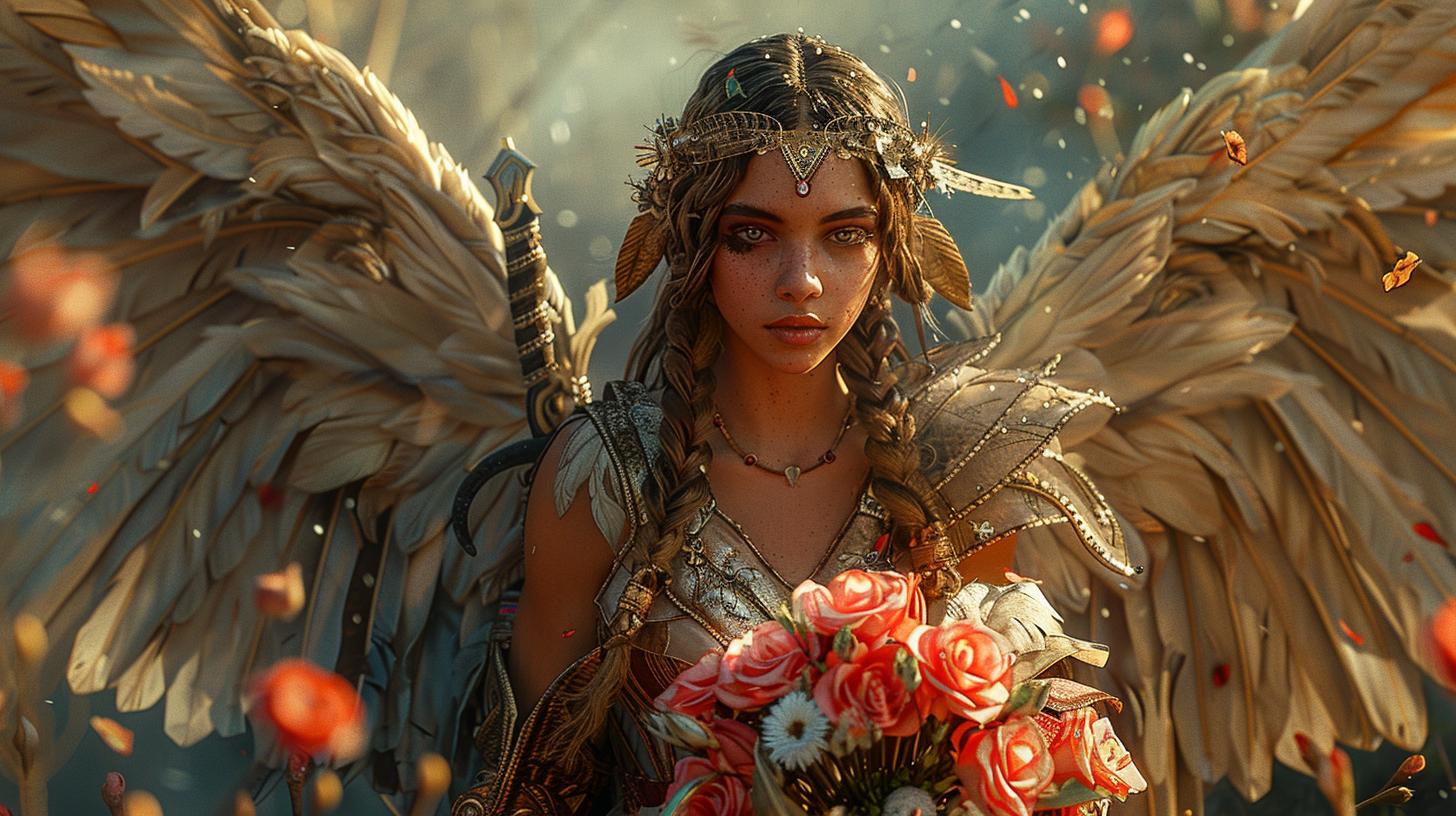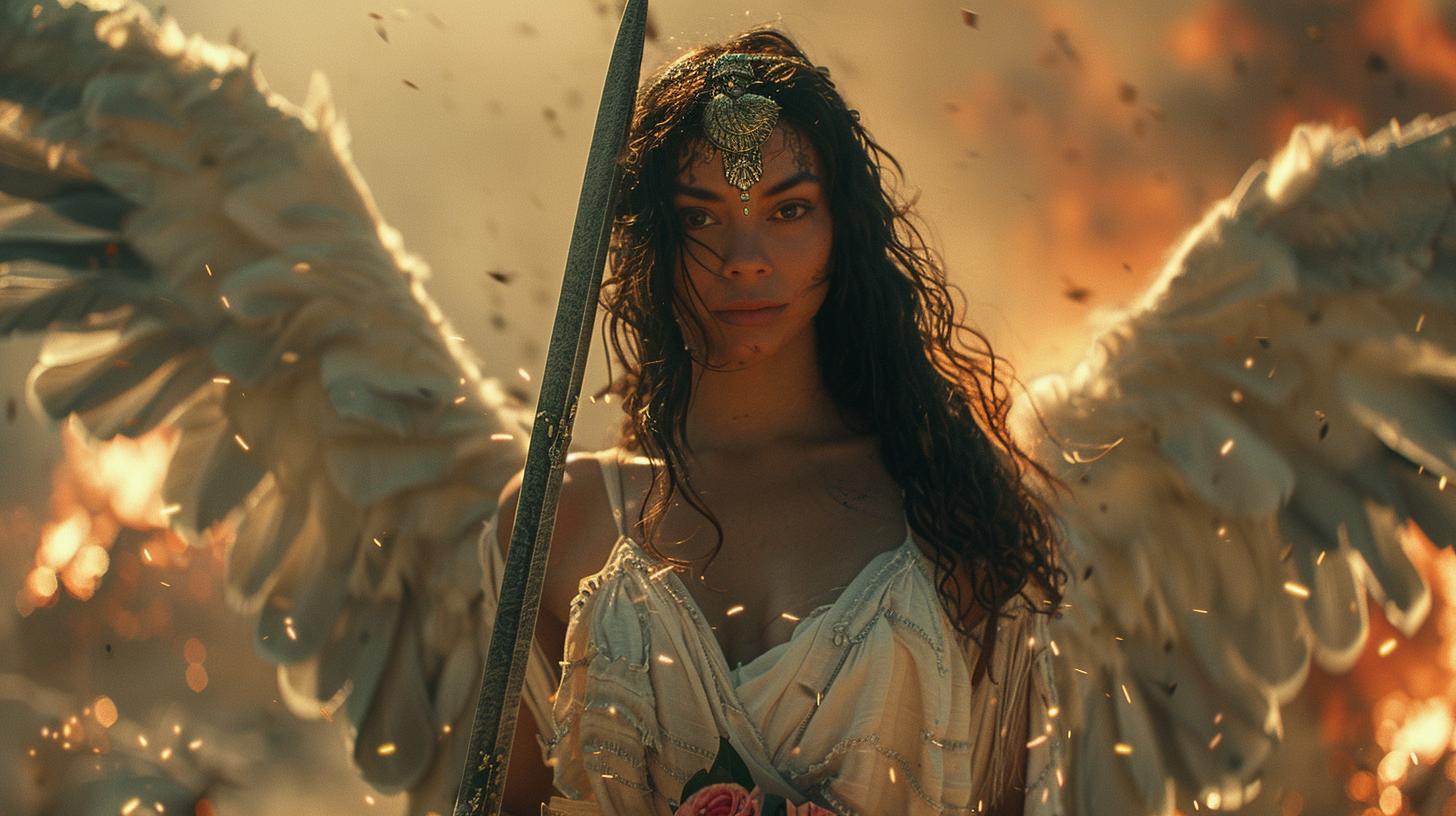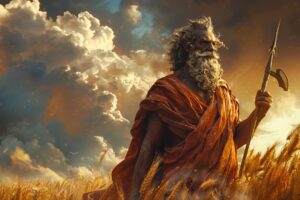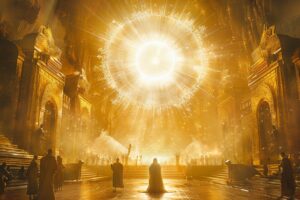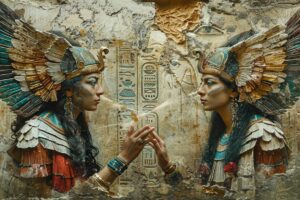Shaushka Goddess: Origins, Roles, and Cultural Impact
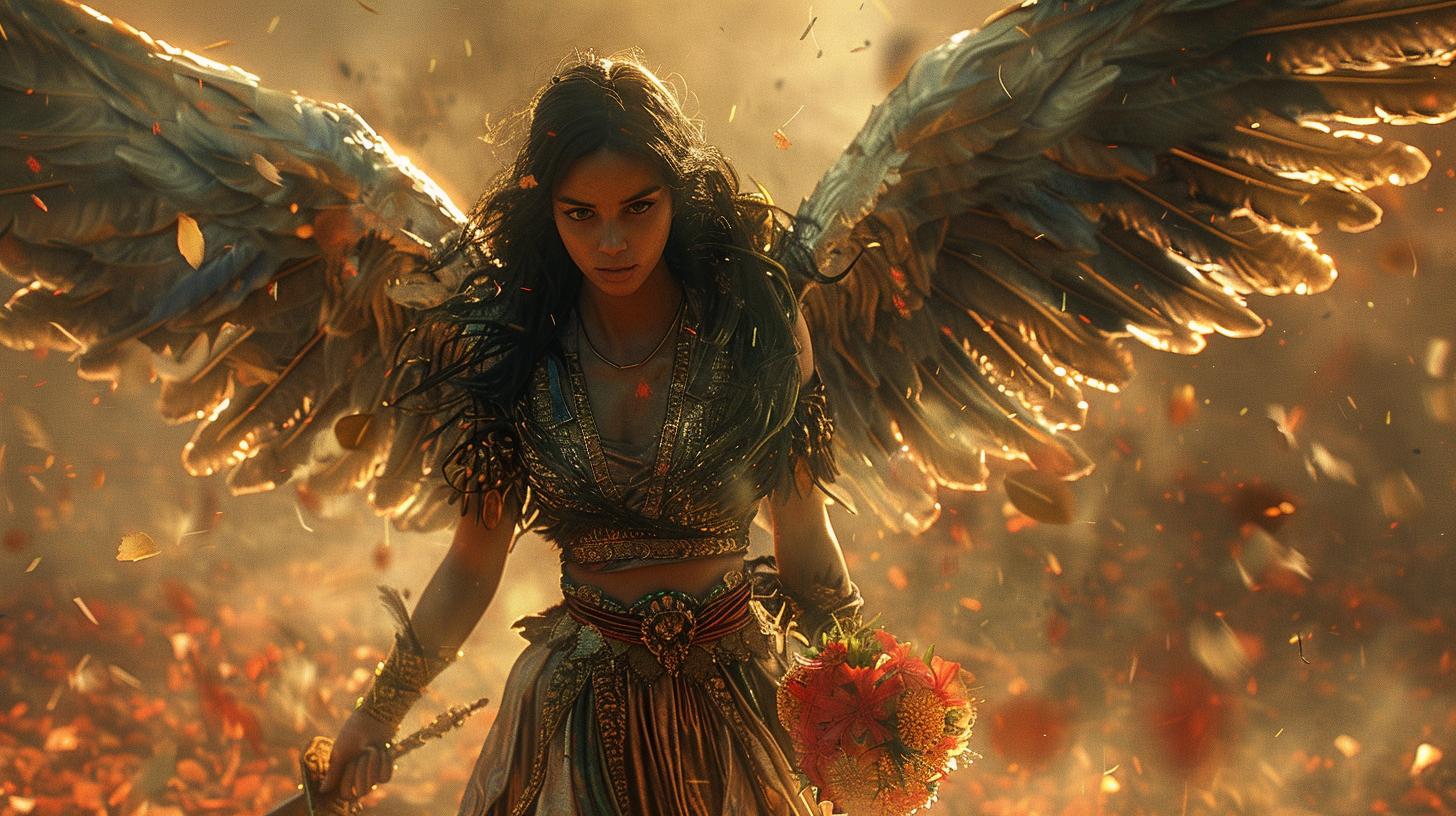
Shaushka was a prominent Hurrian goddess associated with fertility, war, and healing. Known by several names, she was worshipped in various cultures and became especially influential in the Hittite pantheon.
Her roles spanned from goddess of love to fierce warrior. She was also revered for her healing powers. Her imagery often included wings, lions, and doves, and she appeared in many myths, particularly in the Cycle of Kumarbi.
Origin and Name
Shaushka holds a significant place in Hurrian and Hittite mythology, with her origin and name reflecting deep cultural roots and veneration.
The Hurrian Roots
The deity Shaushka originates from the ancient Hurrian culture. Her name in the Hurrian language translates to ‘The Great’ or ‘The Magnificent’, emphasizing her high status in the pantheon. As with many Hurrian deities, Shaushka’s name carries descriptive elements, indicating her revered position.
Variants of the Name
Shaushka’s name appears in various forms across different historical records, indicating a wide recognition and adaptation of her worship.
Logographic Representations
In the archives of Bogazköy, multiple logographic representations of Shaushka’s name have been found. These include:
- dIŠ8-TÁR
- dLIŠ
- dGAŠAN
Syllabic Representations
Shaushka’s name also appears in syllabic forms, showcasing at least eleven variations. In literary texts, logographic representations are more common, though syllabic consistency is noted in specific works like the Song of Hašarri.
Additionally, inscriptions from Mari during the Paleobabylonian period show the name as dŠa-ú-úš–an, often preceded by the epithet allai (‘lady’).
Epithets and Titles
Shaushka was honored with various epithets and titles that highlight her multifaceted nature. Some of the notable titles include:
- Allani (The Lady)
- Mušuni (She of Justice)
- Kumarbi (He of Kumar)
These titles not only emphasize her cultural significance but also her wide-ranging influence in ancient mythology.
Roles and Characteristics
Shaushka was a multifaceted deity with significant roles in love, war, and healing.
Goddess of Love
Influence on Marital Love
As a goddess of love, Shaushka played a pivotal role in influencing marital relationships. Her blessings were believed to ensure harmony and affection between spouses. Couples would often invoke her to strengthen their bond and preserve their marital happiness.
Magical Associations
Shaushka was closely linked to magic and enchantments. She was called upon for rituals aimed at enhancing sexual potency and romantic allure. This magical aspect also enabled her to transform women into men and vice versa, showcasing her control over gender and identity.
Goddess of War
Tactical Roles in Myths
Shaushka was not only a goddess of love but also a fierce warrior. In various myths, she displayed strategic acumen and combat skills. Her tactical prowess was evident in her battles against formidable opponents, such as the sea monster Ḫedammu and the giant Ullikummi.
Martial Imagery
The depiction of Shaushka often included martial elements. She is frequently shown with weapons and in dynamic postures indicative of combat readiness. Her association with warfare underscores her dual nature as both a nurturer and a protector.
Goddess of Healing
Curative Powers
Shaushka’s role as a healer made her a vital figure in medical and therapeutic practices. She was believed to possess the power to cure ailments and bring about physical and spiritual recovery.
People prayed to her for health and well-being.
Ritualistic Practices
Healing rituals dedicated to Shaushka often involved offerings and specific rites. These practices were designed to invoke her curative powers. Ritualistic texts detail various ceremonies that were performed to seek her intervention in cases of illness and injury.
Cultural and Geographical Influence
Shaushka’s influence extended beyond her origin, impacting various cultures and regions significantly.
Association with Nineveh
Shaushka was intimately associated with Nineveh, often referred to as the tutelary goddess of the city. Her strong connection to Nineveh is reflected in various texts, including those from the Third Dynasty of Ur, where she is mentioned as “ni-nu-a-kam,” meaning “of Nineveh.”
This deep association highlights her central role in the religious life of the inhabitants of Nineveh and underscores her importance in regional worship practices.
Expansion in Anatolia
Presence in Yazılıkaya Sanctuary
Shaushka is prominently depicted in the Yazılıkaya Sanctuary, a significant religious site in Anatolia. Here, she is displayed twice, demonstrating her androgynous nature. Once, she appears among the gods accompanied by her maidens, Ninatta and Kulitta, and another time among the goddesses.
These representations reflect her dual attributes and highlight her acceptance and integration into Anatolian religious practices.
Integration into Hittite Pantheon
Shaushka was incorporated into the Hittite pantheon following the Hurrian cultural influence on the Hittites. Her multifaceted roles as a goddess of love, war, and healing made her an essential figure in Hittite religion.
The Hittites adopted her, recognizing her as a powerful deity whose influence could enhance their own religious and cultural framework.
Spread to Mesopotamia
Influence on Ishtar
In Mesopotamia, Shaushka’s attributes closely paralleled those of the goddess Ishtar. The overlap between these two deities in terms of roles and symbols suggests a syncretic blending of their worship.
This influence is evident in the rituals, iconography, and myths where elements of Shaushka were absorbed into the portrayal of Ishtar, symbolizing love, warfare, and fertility.
Connection to Ur III Period
During the Ur III period, Shaushka’s presence extended into southern Mesopotamia.
She was acknowledged and worshipped alongside other deities, pointing to a significant cultural exchange. This period saw her integration into the existing religious practices, demonstrating the fluidity and adaptability of her worship across different regions and cultures.
Iconography and Visual Representations
Shaushka’s iconography and visual representations are rich and diverse, reflecting her complex nature as a goddess of love, war, and healing.
Common Depictions
Winged Figure
Shaushka is frequently depicted as a winged figure, emphasizing her divine and celestial nature. Her wings are often portrayed spread out, symbolizing her power and protective abilities. The winged imagery also underscores her role as a mediator between the heavens and the earth.
Symbolic Animals and Servants
Several animals are symbolically associated with Shaushka, notably lions and doves. She is often shown standing on a lion, highlighting her strength and dominion. Doves, on the other hand, are emblematic of love and peace, aligning with her role as a goddess of love.
Shaushka is also accompanied by her two maidservants, Ninatta and Kulitta, who are depicted alongside her in various representations. These maidens serve to enhance her divine presence and emphasize her importance in the divine hierarchy.
Imagery in Battle
Lion Imagery
Lions are a recurring element in the iconography of Shaushka, symbolizing her fierce and protective nature. The depiction of Shaushka standing on or accompanied by lions conveys her power and readiness for battle.
Lions are traditionally associated with strength and royalty, further reinforcing her status as a formidable deity.
Associated Symbols
Shaushka’s battle imagery includes various symbols associated with warfare. She may be shown holding weapons, such as swords or spears, to signify her martial prowess. Additionally, other symbols like shields or helmets might be included to emphasize her protective and combative roles.
The combination of these elements in her representations serves to highlight her complex identity as both a nurturing and warrior goddess.
Myths and Legends
Shaushka features prominently in various myths and legends, particularly in the Cycle of Kumarbi. Her heroic deeds often involve protecting the natural world and combating malevolent creatures.
Role in the Cycle of Kumarbi
Shaushka plays significant roles in the Cycle of Kumarbi, demonstrating her multifaceted nature. Two critical stories in this cycle are “The Song of Hedammu” and “The Song of Ullikummi.”
The Song of Hedammu
In “The Song of Hedammu,” Kumarbi creates a monstrous sea creature named Hedammu to threaten humanity.
Shaushka uses her charm and strategic wit to neutralize this threat. Disguising herself alluringly, she seduces Hedammu and makes him drink a potion that renders him powerless.
This myth highlights her abilities in both persuasion and strategic combat. By combining her aspects as a goddess of love and war, she successfully protects people from the monstrous threat.
The Song of Ullikummi
“The Song of Ullikummi” tells of another formidable creation by Kumarbi, the giant stone monster Ullikummi. Shaushka again intervenes to protect humanity. However, this tale centers more on her partnership with other gods rather than her solitary heroism.
She brings her unique strengths to the battle, coordinating with her brother Teshub and employing strategic maneuvers. This story demonstrates her importance in divine alliances and her indispensable role in cosmic battles.
Heroic Deeds
Beyond the Cycle of Kumarbi, Shaushka’s legends abound with heroic actions. Notably, her myths often see her combating dangerous creatures and protecting the vulnerable.
Combating the Sea Monster
One of Shaushka’s notable heroic acts involves combating a sea monster known as Ḫedammu. She uses her cunning, charm, and magical prowess to defeat this beast, saving both humanity and the deities.
This tale showcases her dual nature as both a compassionate healer and a fierce warrior. By controlling and overcoming the beast, she ensures the safety and peace of her world.
Protector of the Olive Tree
In another myth, Shaushka protects the personification of an olive tree named Hašarri from various threats. Seeing the tree’s importance, she takes on the role of its guardian.
This story symbolizes her connection to fertility and nature. By protecting Hašarri, she underscores her nurturing aspect and her commitment to preserving life.
Comparisons with Other Deities
Shaushka shares many traits and characteristics with other goddesses from various ancient cultures. These similarities offer insights into the interconnectedness of mythologies and religious practices across regions.
Comparison with Inanna/Ishtar
Shaushka is often compared to Inanna/Ishtar, the Mesopotamian goddess of love, war, and fertility. Both deities exhibit similar domains and iconography. Inanna/Ishtar, like Shaushka, holds significant influence over love and sexuality, often depicted as a beautiful and powerful figure commanding both desire and respect.
Their roles in warfare are also parallel, with Inanna/Ishtar known as a fierce warrior goddess leading armies into battle. Similarly, Shaushka’s martial imagery and her participation in mythological battles align her with these aspects.
In terms of healing, Inanna/Ishtar has associations with restorative powers, akin to Shaushka’s role as a healer. This comparison highlights the shared attributes of these goddesses in the spheres of love, war, and healing.
Similarities to Astarte and Aphrodite
Shaushka also bears similarities to Astarte, the Canaanite goddess, and Aphrodite, the Greek goddess. Both Astarte and Aphrodite are deities of love and fertility, sharing aspects of Shaushka’s domain.
Astarte, often associated with sexuality and fertility, mirrors Shaushka’s influence on marital love and her ability to affect sexual potency. The iconography of Astarte, featuring symbols of fertility like lions, doves, and the crescent moon, resonances with Shaushka’s symbolic animals and servants.
Aphrodite, the Greek counterpart, further exemplifies these connections. Known for her unmatched beauty and role in romantic affairs, Aphrodite’s attributes parallel Shaushka’s influence over love and attraction.
Though primarily known for love, Aphrodite also has myths connected to martial aspects, similar to Shaushka, who embodies both love and war.
Connections to Other Goddess Archetypes
- Usha (Ushas) from the Rig Veda in India appears as a dawn goddess with roles in fertility and renewal, showing thematic links to Shaushka’s regenerative aspects.
- Isis from Egypt, who embodies motherhood, magic, and healing, parallels Shaushka’s curative powers and her deep involvement in magical practices.
- Amaterasu from Japan, the sun goddess and queen of the heavens, shares elements of authority and reverence akin to Shaushka, highlighting her esteemed position among deities.
These connections underline how Shaushka fits into a broader spectrum of goddesses who blend roles traditionally attributed to both male and female deities, illustrating the complex spiritual landscape of the ancient world.
Influence and Syncretism
The goddess Shaushka’s cult and influence extended far beyond her Hurrian origins, integrating into multiple cultures and regions.
Integration into Different Cultures
Influence in Kizzuwatna, Alalakh, Ugarit
Shaushka’s worship spread widely, including areas like Kizzuwatna, Alalakh, and Ugarit. Her multifaceted nature resonated with local customs in these regions.
- In Kizzuwatna, her cult was renowned for its elaborate rituals that combined Hurrian and Hittite elements.
- In Alalakh, she was revered as a guardian figure, blending with local deities to form a unique syncretized worship.
- In Ugarit, her influence is evident in the incorporation of her attributes into local mythologies and religious practices.
Adoption in Nuzi and Ulamme
In the northeast regions of Mesopotamia, such as Nuzi and Ulamme, Shaushka’s presence was particularly notable.
Her attributes merged with those of local deities, signifying her adaptability and the appeal of her divine powers across different communities.
- Nuzi worship included invoking Shaushka in healing rituals and military campaigns.
- In Ulamme, her imagery and iconography influenced local art and religious symbols.
Impact on Egyptian Culture
The Amarna Letters
The Amarna Letters are a crucial source of information on diplomatic relations between Egypt and neighboring regions.
Among these, references to Shaushka highlight her significant role in fostering political and cultural bonds.
She was often mentioned in the context of royal exchanges, reflecting the high esteem in which she was held.
Statue Exchange: Symbolism and Purpose
One of the notable instances of Shaushka’s influence in Egypt was the exchange of her statue. The Mitanni king Tushratta sent a statue of Shaushka to Egypt as a diplomatic gesture.
- This exchange was part of the marital arrangements involving Taduhepa, Tushratta’s daughter, who was to marry Pharaoh Amenhotep III.
- The statue symbolized life, fertility, and divine protection, serving both as a blessing and a means of securing political alliances.
Modern Interpretation and Relevance
Today, the figure of Shaushka continues to influence both academic discourse and popular culture in significant ways.
Scholarly Debates
Modern scholarship on Shaushka involves multifaceted discussions and analyses. Researchers debate her origins, roles, and influence on later deities. These debates often focus on:
- Her syncretism with other Near Eastern goddesses such as Ishtar and Astarte
- The duality of her nature as both a fierce war goddess and a nurturing fertility deity
- Her cultural and religious significance in Hurrian and Hittite societies
There is a rich body of literature examining her representation in ancient texts and iconography, reflecting broader themes in ancient Near Eastern religion and mythology.
Cultural Legacy
Shaushka’s enduring legacy is evident in multiple cultural narratives and historical contexts. Her depiction in various ancient myths, alongside her consistent role as a protector and healer, underscores her importance:
- Her presence in the myths of the Hurrians and Hittites
- Her assimilation into the pantheons of neighboring cultures
- Continued reference to her in historical texts and artworks
These aspects highlight her impact on subsequent religious traditions and the transmission of divine archetypes across cultures.
Representation in Contemporary Media
Shaushka’s influence extends into modern media, where she is often reinterpreted and reimagined in various forms:
Popular Culture
In recent years, Shaushka has appeared in novels, video games, and films that explore ancient history and mythology. These representations often portray her as a powerful and multifaceted figure, reinforcing her complex nature:
- Fictional narratives that incorporate her myths and legends
- Video games that feature her as a character or divine entity
- Documentaries and educational programs focusing on ancient religions
Academic Publications
Shaushka continues to be a subject of extensive research and publication in academic circles.
Scholars frequently publish articles, books, and papers examining her role and significance:
- Peer-reviewed journals addressing ancient Near Eastern deities
- Books dedicated to the study of Hurrian and Hittite mythology
- Conferences and symposiums discussing her influence on historical and religious studies
These platforms ensure that the study of Shaushka remains dynamic and continually evolving, reflecting ongoing interest and scholarly engagement with this ancient goddess.

